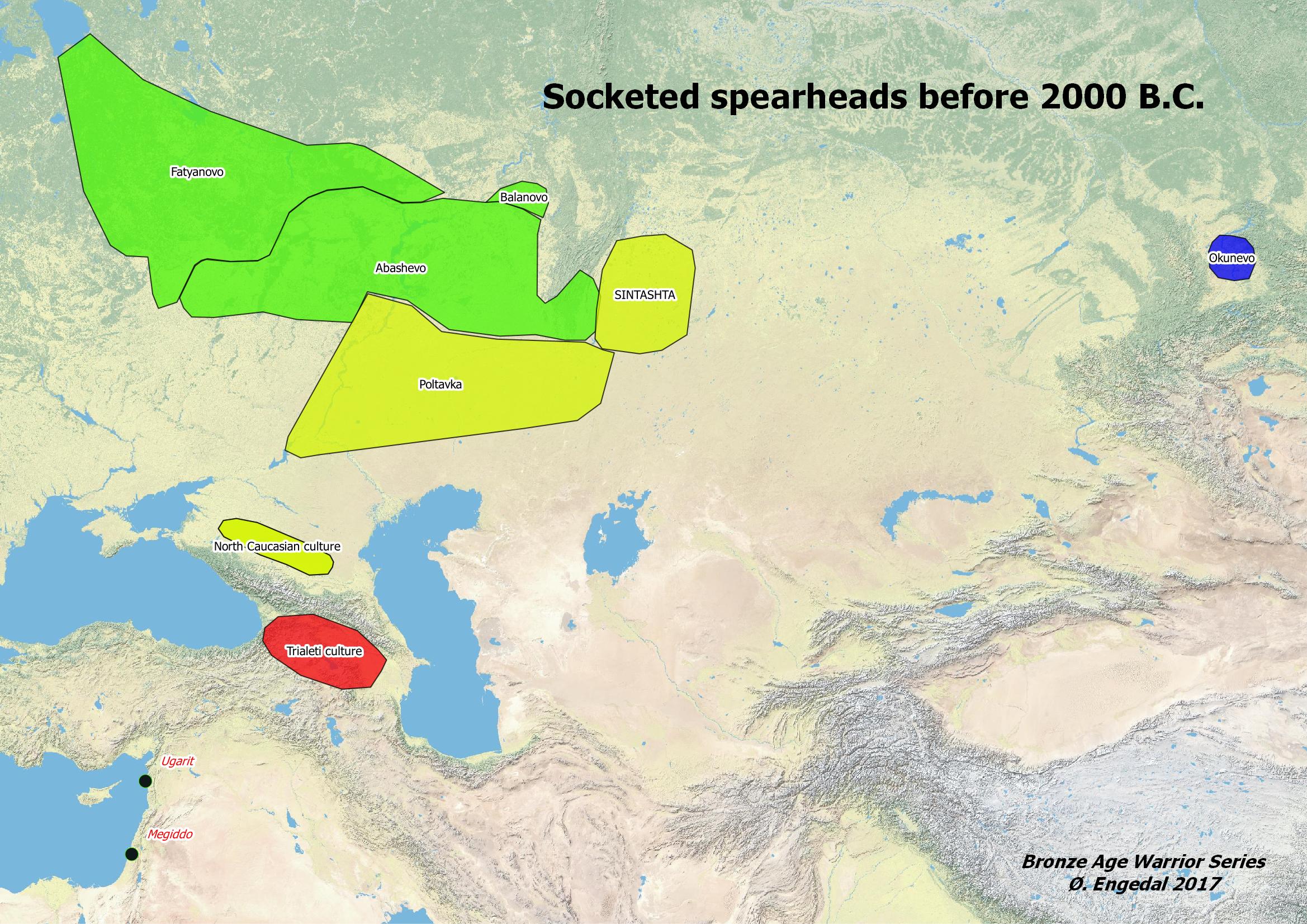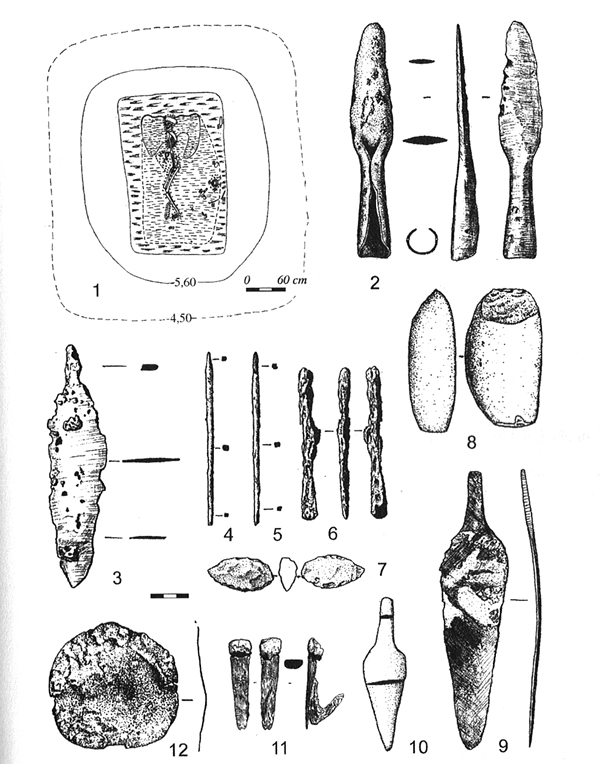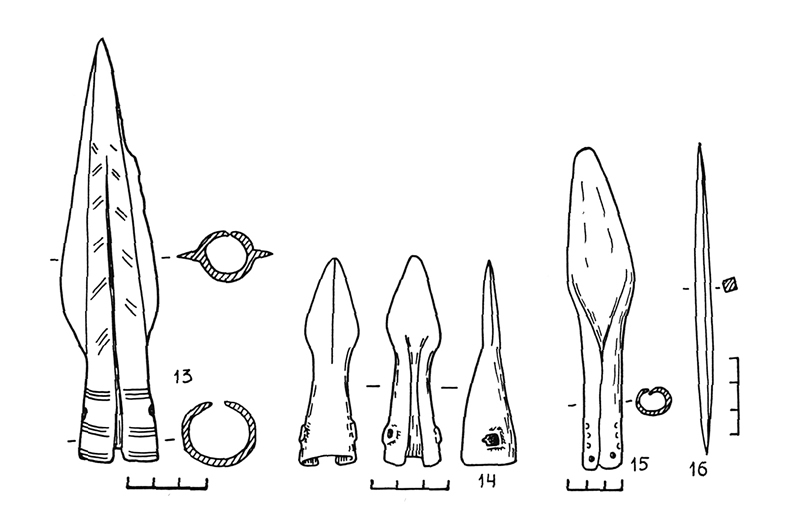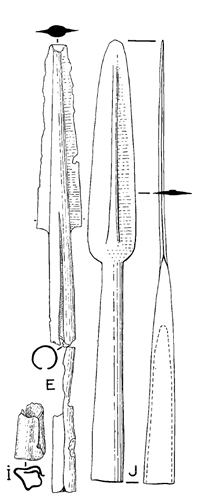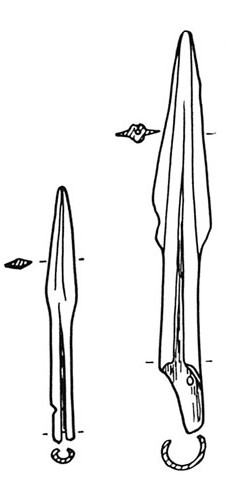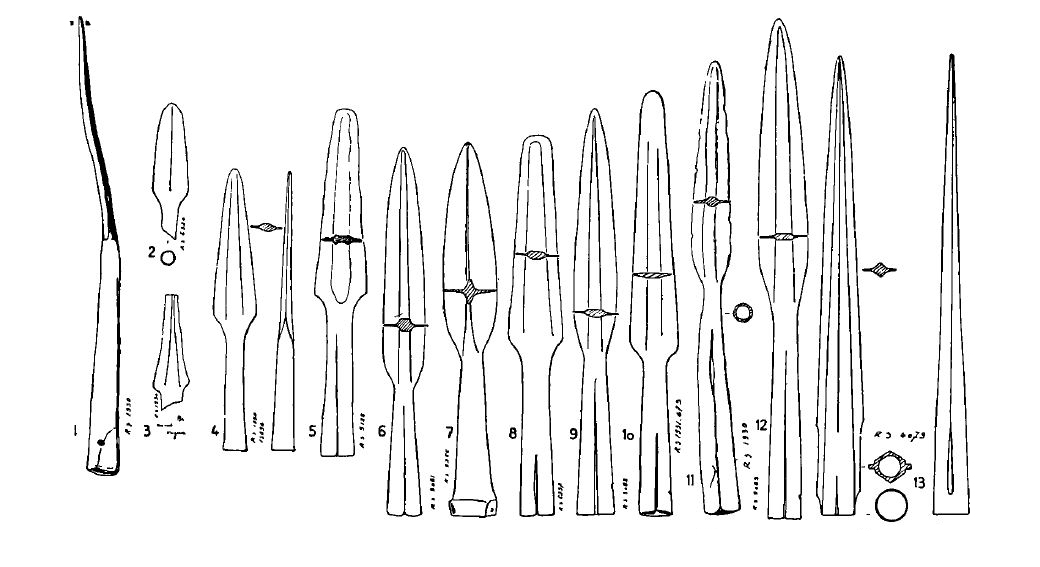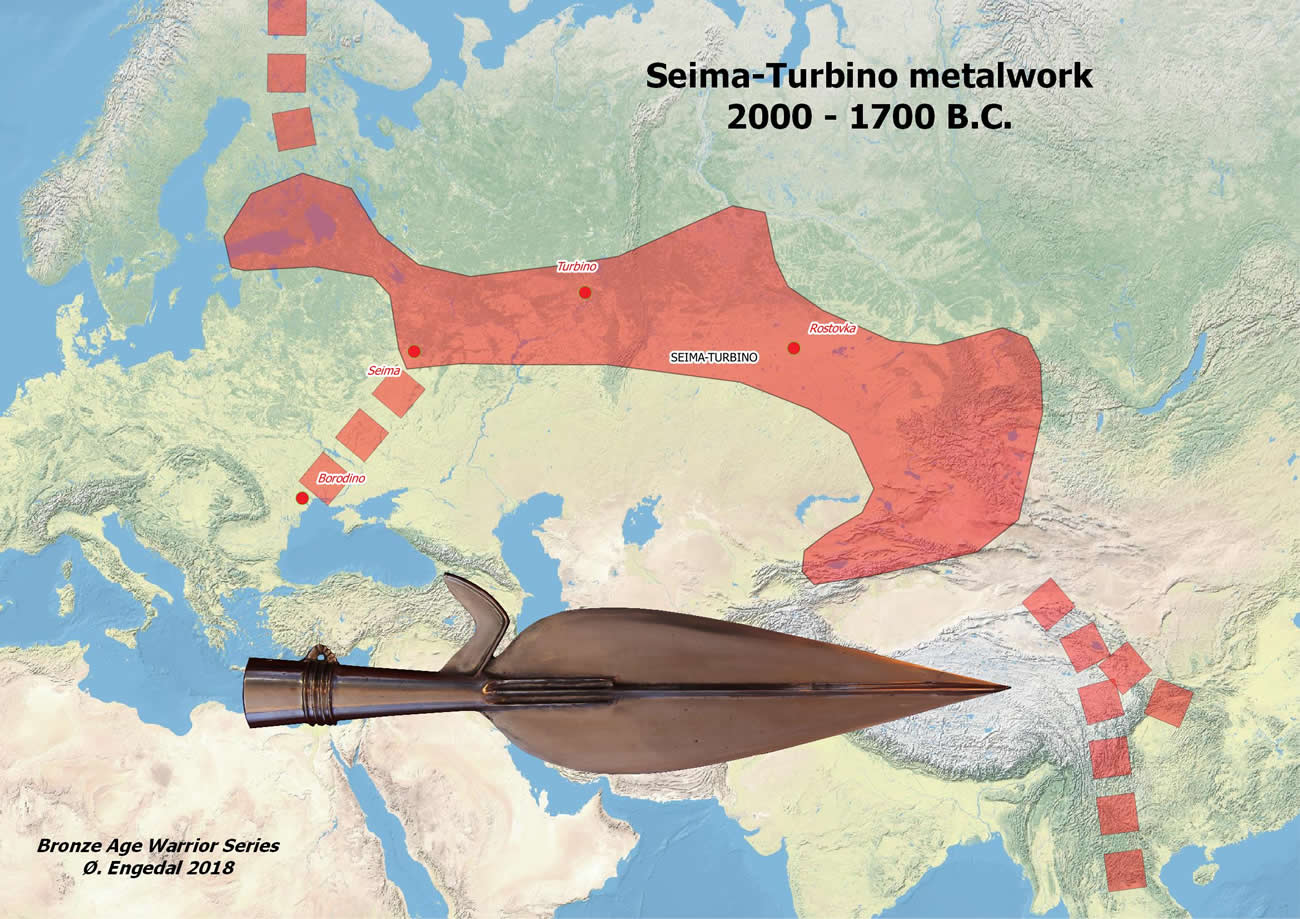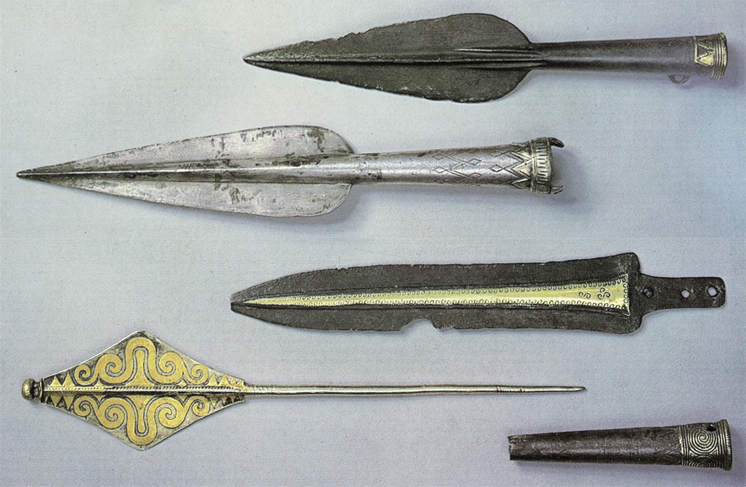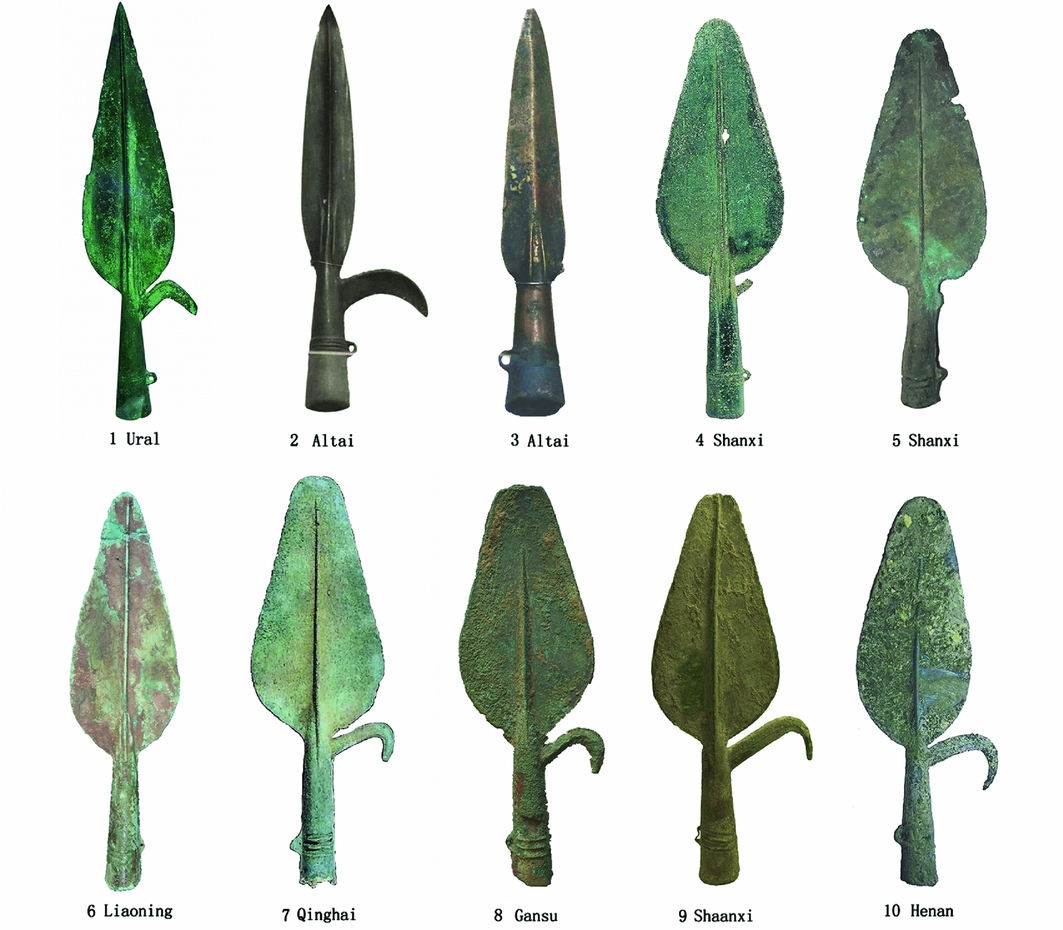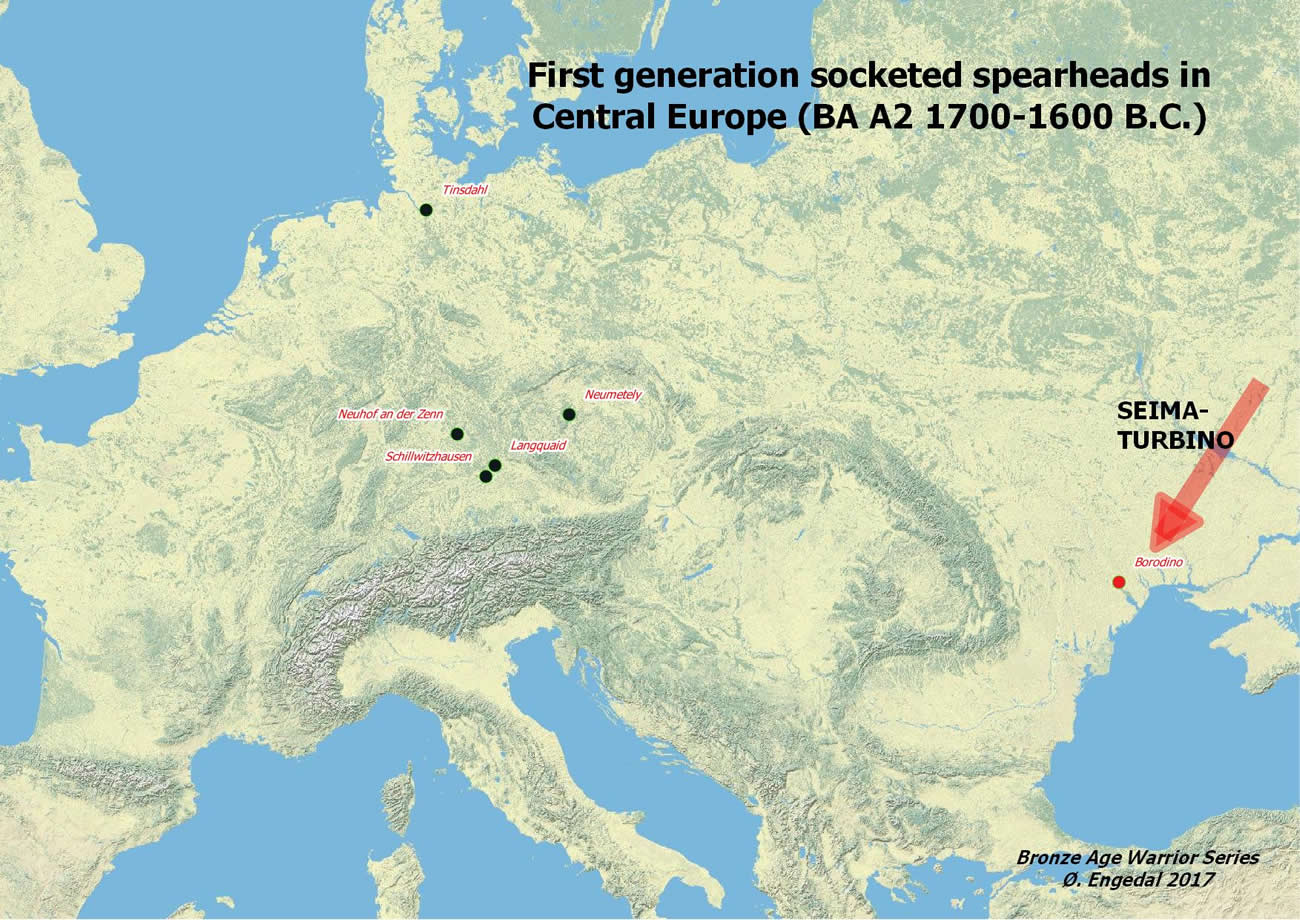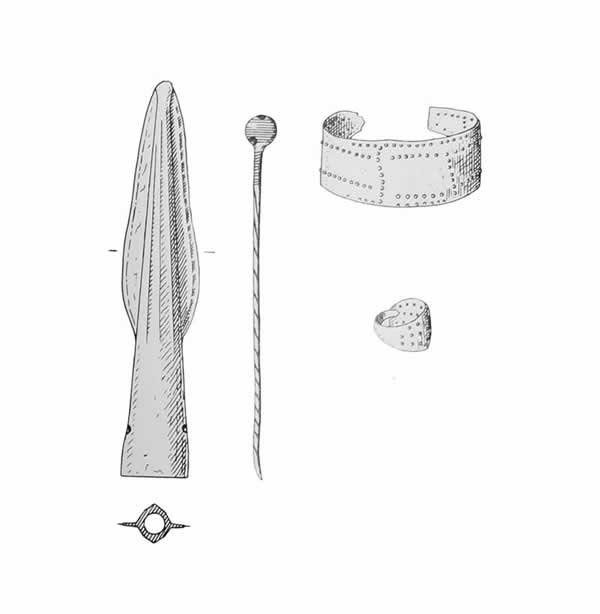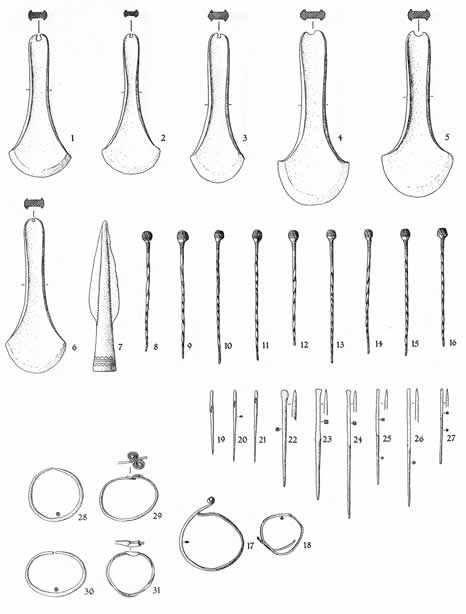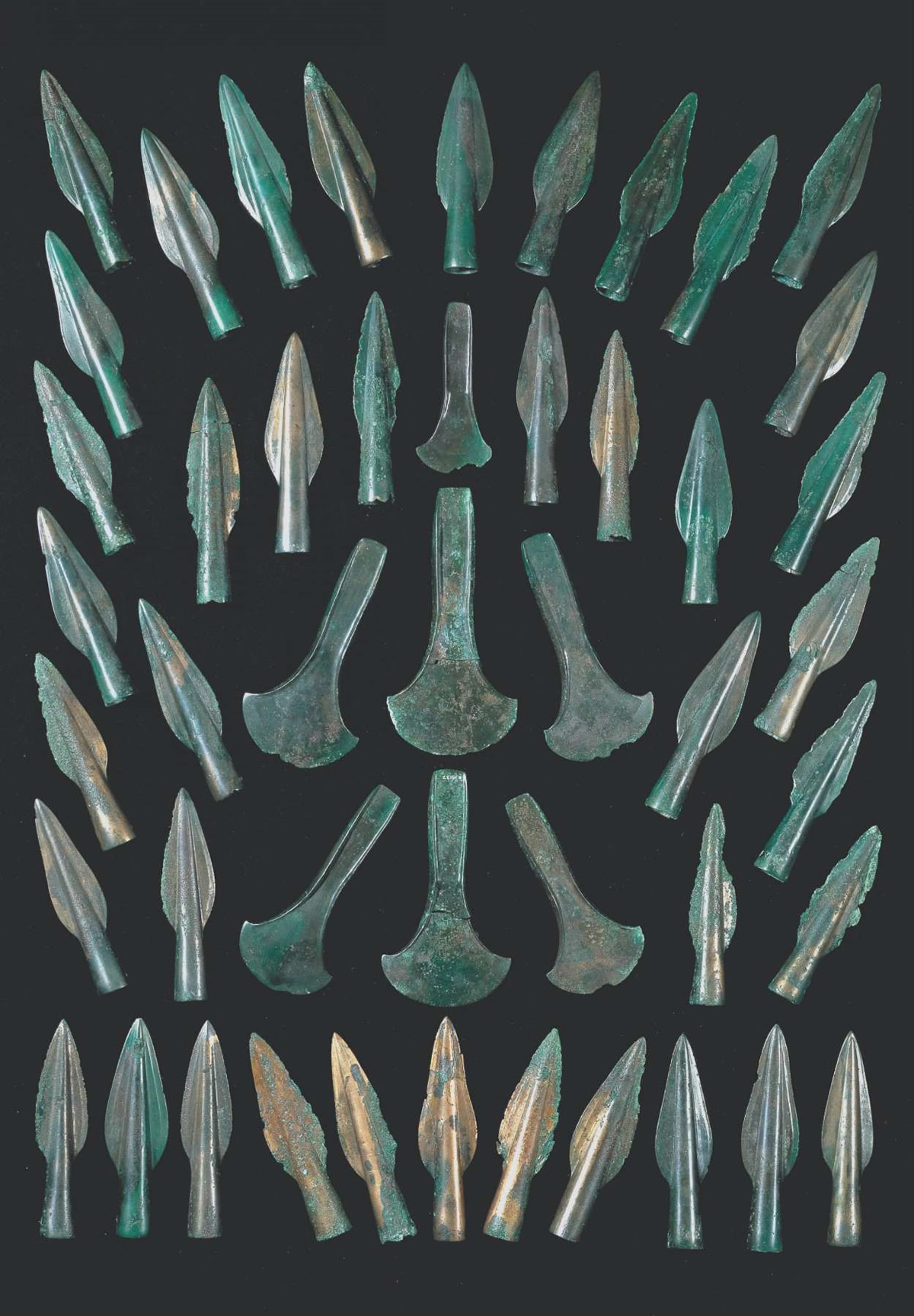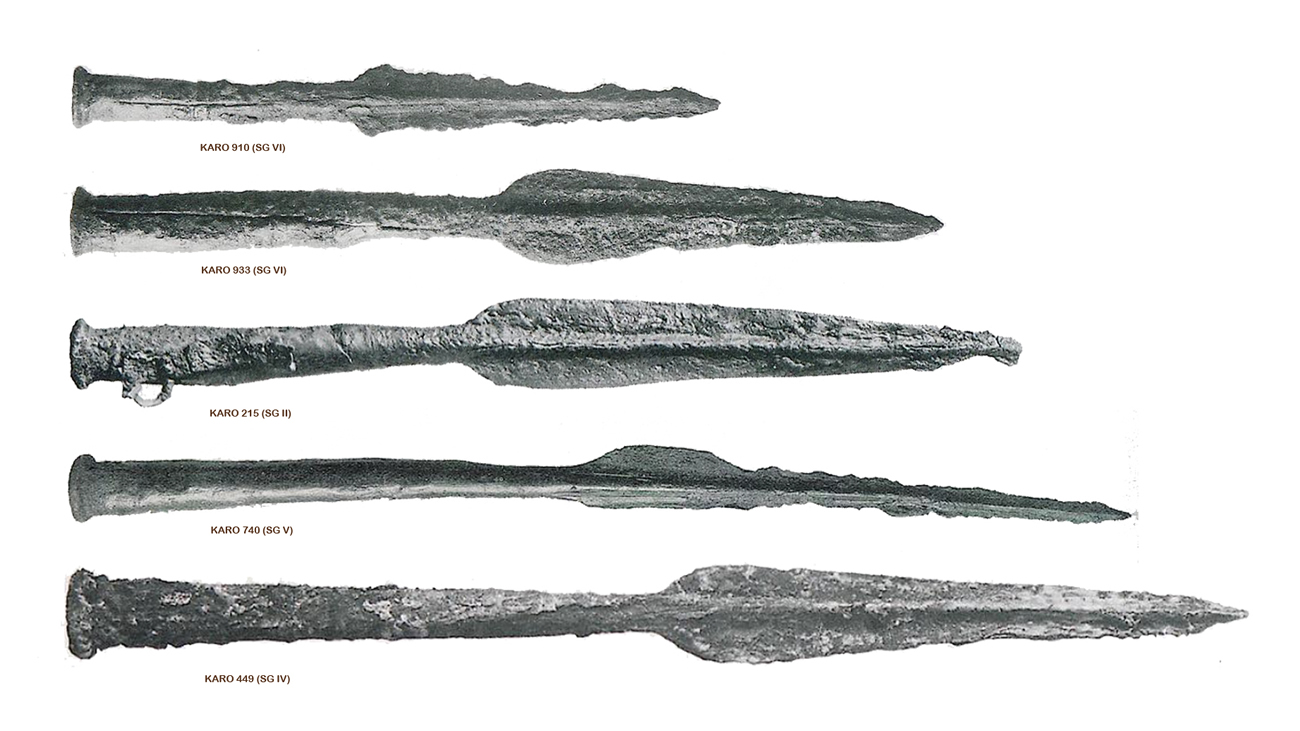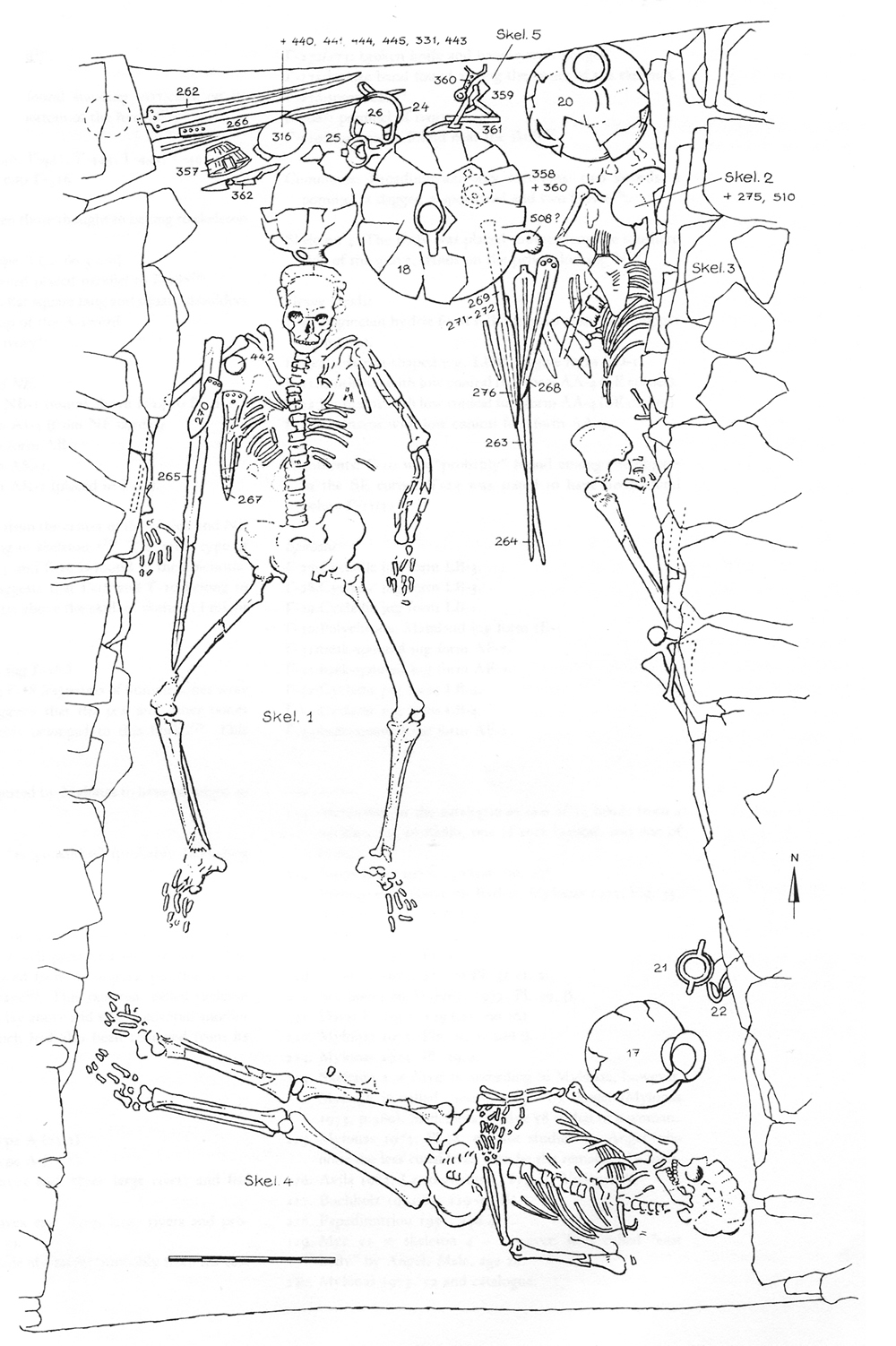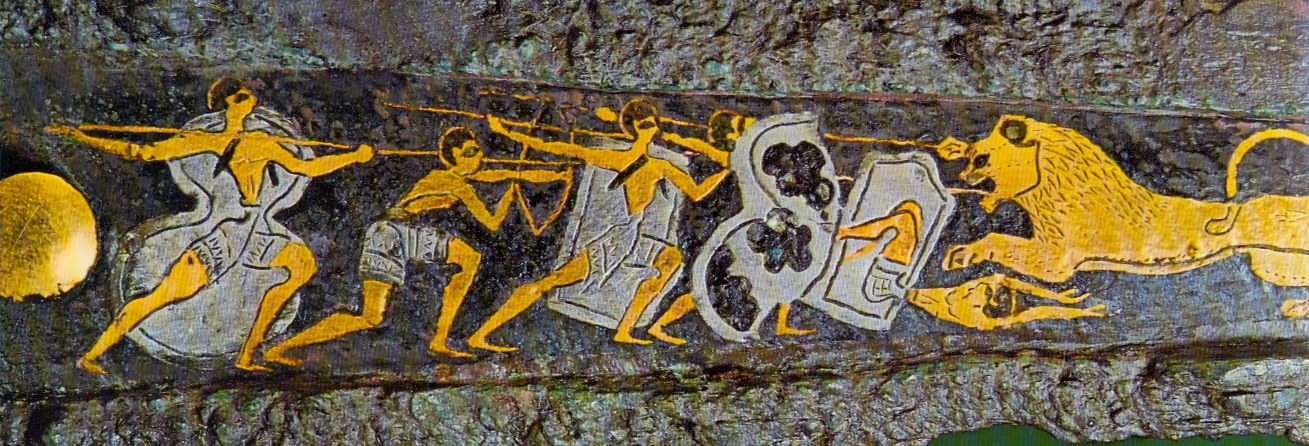The Spearhead, chapter II: The development of the socketed spearhead 2200-1600 B.C:
Home > The spearhead > Chapter II
The first socketed spearheads appeared somewhere between 2300-2000 B.C. in a large area from the Levant, via Caucasus to the forest-steppe region west of the Ural. There are several pre-2000 B.C. (Early Bronze Age) specimens in the Near East. Burial 1101 at Megiddo is one, dated to the end of the EBA. There are also two quite developed specimens from Ugarit (Chambre E-F, EBA III). The Trialeti culture of Transcaucasus is considered to be a zone of early innovation towards socketed spearheads. It is not entirely clear how numerous they were in the first part of the Trialeti sequence (phase I and II, 2500-2000 B.C.). At present socketed spearheads seem to be both earlier and more common in the Ural area, the forest-steppe culture of Fatyanovo and Balano and the Poltavka cuture. From these, probably, the spearheads of the Abashevo (2500-1850 B.C.) and Sintashta culture (2100-1800 B.C) were developed, also before 2000 B.C.
Map showing the distribution of socketed spearheads before 2000 B.C. Green designates areas in the forest-steppe zone, yellow in the steppe zone. |
||
Bolshoi Bodyrevsky burial from Poltavka (or late Pit-Grave) horizon, with early socketed spearhead and two iron objects (Koryakova & Epimakhov 2007)
Spearheads from the Fatyanovo and Balanovo cultures. Method of production of early socketed spearheads (from El Morr 2011). |
||
Early Bronze Age spearhead from Megiddo burial 1101. |
Early Bronze Age spearheads from Ugarit, Chambre E-F (Schaeffer 1962) |
Early Bronze Age spearheads from Ugarit, «poche aux |
Spearheads from the North Caucasian culture (from Chernykh 1992). |
Spearhead from Sintashta burial 30 (Kohl 2007) |
|
|---|---|---|
Left: Diagram showing the likely method of production of the more developed spearheads with split-sockets (from El Morr 2011). |
||
Surprisingly, while the spearhead with split-socket is still a novelty west of the Ural, and in the Near East, spearheads with a full cast socket appear in the Minusisk basin in the Altai foothills to the far east. This is seen in the Moseikha burial within the Okunevo culture. This is an important clue to the origin of the more famous full-socketed spearheads of the subsequent Seima-Turbino horizon in this area. |
||
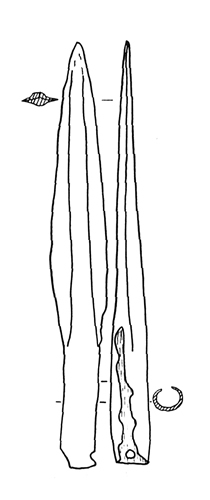 |
Left: Spearhead from Moiseikha, Okunevo culture in the Minusinsk basin, full cast socket, before 2000 B.C. (from Chernykh 1992) |
|
2000-1750 B.C. in the Near East
|
||
Left:Socketed spearheads with base collars from Ugarit, Middle Bronze Age (right, Schaeffer 1939). |
||
Socketed spearheads from Middle and Late Bronze Age Ugarit (Schaeffer 1962) |
||
Left: Spearheads with split sockets from the Trialeti culture (phase III) of Transcaucasus, c. 2000-1750 B.C. Notice number 1 and 2 with base collars from gold and silver. |
||
The Seima-Turbino and the spread of spearheads with cast sockets 2000 - 1700 B.C.The Seima-Turbino phenomenon has for long had a particular status in Russian archaeology. Recent work in radiocarbon dating, new findings, and an "opening" of the archaeology of China, now give us a clearer view of the issue. It is characterized by high quality tin-alloy bronze weaponry, with socketed axes, socketed spears, and knives with figurative lost-wax cast handles. Finds of pieces of complex bone lamellar armour can be added to the martial nature of the phenomenon. These bronzes appear in an east-west belt from China to the Carpathians and Sweden, not in the steppe area but along the forest-steppe zone further north. The most distinct type is the "forked" socketed spearhead, the "fork" separating it from all later variants of socketed spearheads.
The date of the Seima-Turbino horizon was for a long time based on parallells in the shaft-graves of Mycenae, and thus placed after c. 1650 B.C., even 1500-1400 B.C. Recently the date has been shifted to 2200-1900 B.C. based on new sets of radiocarbon dates from Seima-Turbino cemeteries in western Siberia, including the key site of Rostovka (Marchenko et al. 2017). It has also become apparant that radiocarbon results can be skewed in regions and periods were people relied heavily on a diet of freshwater fish (FRE). It seems now that such a diet may be able to offset results by 200 C14-years and more. David Anthony has found a middle ground, and landed tentatively on around 1900 B.C. (2007). This would fit with typological evidence and cross-findings: a Sintashta type split-socketed spearhead was found at the Seima-Turbino cemetery of Rostovka, and a Seima-Turbino spearhead with cast socket was found in a chariot burial at Krivoe Ozero (Petrovka culture, sister to the Sintashta culture). I believe we also need to fit into this the western hoard that for long provided the former "low" chronology: the hoard from Borodino, Odessa in Moldavia.
The metal artefacts from the Borodino hoard. The Borodino hoard contained a forked spearhead of unequivocal Seima-Turbino type. The other complete spearhead is also related to Seima-Turbino, but made from silver. A third fragment cannot be defined. All three spearheads has added gold ornaments at the base of the socket. The use of silver and gold clearly separates this hoard from the rest of the Seima-Turbino assemblages, and I believe that the spiral ornament in particular, but also the ornament of the pin and the type of dagger, point to the Aegean. Dating the Seima-Turbino metalwork to 2200-1900 B.C. makes it impossible to make a link to the inventory of the shaft-graves at Mycenae. Possibly there is a missing link here, but it could also be that the end of the Seima-Turbino horizon ought to be stretched towards 1650 B.C., at least in the west. It now seems clear that bronze technology, and thus the Bronze Age, was introduced to China from the steppe. The first signs of a linkage are weapons of Seima-Turbino types: knives, daggers and spearheads, in the Erlitou period (1700-1500 B.C.), before the Shang dynasties. While some of the knives and daggers could be linked to the Karasuk culture rather than Seima-Turbino, the spearheads make a rather clearcut link to the Seima-Turbino horizon and Rostovka in particular. Now four spearheads with socket and hook are reported from China, the one from Xining being 61 cm long. The one from Shanxi has also the "fork" at the transition socket-blade, and the link to the west is beyond argument. The hooked variant was characteristic to the Rostovka cemetery with 4 specimens. The spread of Seima-Turbino style spearheads into China (from Linduff 2017).
Comparison of spearheads from the Seima-Turbino complex (1-3) and China (4-10). From Meicun & Xiang 2017. Previously, the beginning of the Bronze Age in Thailand has been explained largely as a result of contact with the Shang of China. Recent research now suggest that the first bronzes are better linked to the steppe corridor, and the Seima-Turbino horizon (White & Hamilton 2009).
|
||
The first generation Central European spearheadsEurope north of the Aegean seems not to have been interested in spearheads made from metal before 1700 B.C. Large numbers of both simple and advanced daggers were made, as well as halbards, but not any form of tanged spearhead as we might have expected. The hoard from Kynha, Saxony in Germany, contained an interesting rarity, a slotted spearhead of Aegean/East Mediterranean type. Along with it was pins and other objects from the A1b phase of the Unetice culture. Suddenly, in phase BA A2 (1700-1600 B.C.), a developed form of spearhead with full cast socket appears in Central Europe. This happened at a time when the split-socketed spearhead reached the Aegean to the south (c. 1750-1700 B.C), and the Seima-Turbino forked spearhead with full cast socket reached the northwestern shores of the Black Sea. This seems too much a coinsidence, and I suspect these processes was interlinked. When it comes to overcoming the technological challenges of casting socketed spearheads, I do think these are somewhat exagerrated. At least viewed from Central Europe: evidence of 200 years of casting hollow dagger hilts, and even long hollow handles for halbards, indicate that the case of the socketed spearhead was not the case of a transfer of technological expertice.
Spearheads from BA A2 or Langquaid phase (A2b according to David 2006, 2015).
Hoards with first generation spearheads (Languaid phase): Tinsdahl (left) and Languaid (right). From Jacob-Friesen 1967. The Schillwitzhausen hoard was discovered in 2012, a significant assembly from the BA A2b (Langquaid phase) with a decorated spearhead. From: David, W. 2015.
The first generation spearheads in the Carpathian ran parallell to the Hadjusamson horizon, c. 1600 B.C., and is thus too late to provide a link between Seima-Turbino spearheads (Borodino) and the first series in Central Europe (David 2006, 2015).
Spearhead in the Mainz collection, from "Hungary" (David 2006). The tempo is astounding, and it could be that archaeological periodisation does not capture the spread in detail: parallell to the first generation in Central Europe, production of socketed spearheads starts in the Nordic zone. While David finds 4 spearheads in A2 assemblages across Central Europe, Vandkilde finds 3 Central European imports and 63 locally produced socketed spearheads in Denmark in the same chronological phase (Nordic BA IA) (David 2006, 2015; Vandkilde 1996). The chronological synchronization here seems solid, as the Torsted, Virring and Åbjerg hoards of the Nordic zone could be linked to the Tinsdahl hoard by several factors. They all contained imported Central European style spearheads alongside the more uniform locally produced spearheads, as well as flanged axes of Torsted-Tinsdahl and Virring types. At a time when spearheads were few and not quite had found its shape in Central Europe, founders in the Nordic zone engaged in mass production of quite uniform spearheads (type Bagterp, variant Torsted). The Torsted hoard with 40 spearheads is unique on the larger Eurasian scene at this time. Before c. 1500 B.C. the socketed spearhead reached Britain, Norway, Italy and France.
The hoard from Torsted in western Jutland dates to 1700-1600 B.C. and contained 40 spearheads and 7 flanged axes. From Jensen 2002. The spearheads of the early MycenaeansThe large spearheads from the Mycenaean shaft-graves represent the first socketed spearheads on the Aegean mainland, probably also in the entire Aegean (Avila type II; Höckmann group C). The Mycenaeans did not invent the socketed spearheads. The type with an "open" or "split" socket had an earlier appearance in the forest-steppe area of Volga-Kama (Fatyanovo-Balanovo culture, before 2000 B.C.) and Ural (Sintashta culture, before 2000 B.C.), in the Transcaucasus (Trialeti culture, before 2000 B.C.) and in the Near East (before 2000 B.C.). The use of a separate collar at the lower end of the socket also had been invented elsewhere. What separated the early Mycenaean spearheads on the global scene c. 1650 B.C. was their size and uniform appearance. In the cross-section of the blade they seem related to the contemporary type A swords. On the other hand, while the swords very often show complex midribs and gold embellished handles, and quite a few scholars have questioned their functionality since their discovery, the spearheads give an impression of simplicity and brute functionality. Drawing of the original spearhead from shaft-grave IV (from Avila 1983: nr. 12).
Avila type II spearheads from Circle A at Mycenae, ranging from 32 cm to 60 cm (assembled from Karo 1930/33). Similar spearheads were also found in Circle B at Mycenae. This burial site was established earlier than Circle A. The spearhead from S-G N, a burial that belongs in Middle Helladic IIIB (according to Dietz 1991), moves the presence of these spearheads to 1750-1700 B.C. This is in fact the only spearhead with a complex cross-section from the shaft-graves at Mycenae (two narrow, raised ribs on each side of the mid-rib). Spearhead from MH IIIB, Circle B, S-G N (from Avila 1983: nr. 10).
The large spearheads of Höckmann type C/Avila type II also appeared in grave circle B at Mycenae, here seen in situ in S-G Gamma, 51, 5cm long (from Mylonas 1964). The very same burial that yielded the replicated spearhead, also yielded two scenes with large spears in use. One is the hunting scene on the famous Lion-Hunt dagger, the other from a silver rhyton shows warriors with figure-of-eight shields fighting warriors with rectangular shields, both parties wielding long spears. Both these scenes show spearheads on long shaft used in a "high-position"
Hunting scene with long spears, from Mychenae shaft-grave IV.
Scene from silver rhyton from Mycenae shaft-grave IV, here in a reconstructed and straightened image (from http://antiquatedantiquarian.blogspot.no) When it comes to the origin of the Mycenaean spearhead, I believe that it was a novelty inspired by spearheads from Byblos and Ugarit in the Levant. Here they met quite large specimens, and here sometimes a collar/ring was used. On this basis they created their own large and robust type of spearhead. It is also at Byblos and Ugarit we find the best examples of the use of complex niello and inlay techniques (on the kopeshes/sickle-swords group II), comparable to those seen on the Lion-Hunt dagger and other objects in the shaft-graves.
The socketed spearheadThe spread of the socketed spearhead 1900-1600 B.C. must be one of the most remarkable spread of military technology in human history: from China and Thailand in the east to the Atlantic and North Sea in the west. In some regions it might have been linked to the spread of long swords (Aegean, Caucasus), in other regions it might have been linked to the spread of war-chariots, horses, and perhaps lammellar armor. At heart of understanding this significant step in the history of warfare stands the Seima-Turbino phenomenon. |
||
The Bronze Age Spearhead Series includes seven items from this stage:
<Previous chapter - Next chapter >
Litterature:
Avila, R. A. J. 1983: Bronzene Lanzen- und Pfeilspitzen der griechischen Spätbronzezeit. PBF V.1. München.
David, W. 2006: Aus der grossen ungarischen Tiefbene bis zum Fuss der italienischen See-Alpen: Reichverzierte Lanzenspitzen als Zeugen überregionaler Beziehungen altbronzezeitlicher Eliten. In: Studio di Protostoria in onore di Renato Peroni: 213-231. All'Insegna del Giglio s.a.s. Firenze.
David, W. 2008: Älterbronzezeitliche Depotfunde Ostbayerns im Lichte ihrer überregionalen Bedeutung. In: Schmotz, K. (Hrsg.), Vorträge des 26. Niederbayerischen Archäologentages (Rahden/Westf.) 197–237.
David, W. 2015: Bronzedepotfunde der Früh- und Mittelbronzezeit in Ostbayern. In: Husty, L. et al. Archäologische Arbeitsgemeinschaft Ostbayern/West- und Südböhmen/Oberösterreich: 87-111. Verlag Marie Leidorf GmbH.
Dietz, S. 1991: The Argolid at the transition to the Mycenaean age : studies in the chronology and cultural development in the shaft grave period. National Museum of Denmark. Copenhagen .
El Morr, Z. 2011: LA METALLURGIE DU LEVANT AU BRONZE MOYEN A TRAVERS LES ARMES. PhD, Université Michel de Montaigne Bordeaux 3.
Höckmann, O. 1980: Lanze und speer im spätminoischen und Mykenischen Griechenland. In: Jahrbuch RGZM 27 (13-158).
Jacob-Friesen, G. 1967: Bronzezeitliche Lanzenspitzen Norddeutschlands und Skandinaviens. Hildesheim.
Jensen, J. 2002: Danmarks Oldtid. Bronzealder 2000-500 f.Kr. København.
Karo, G. 1930/33: Die Schachtgräber von Mykenai. Text und Tafeln. München.
Linduff, K. 2017: China and the steppe: reception and resistance. Antiquity. Vol 91. Issue 356 (375-388).
Marchenko, Z. V., Svyatko, S.V., Molodin, V. I., Grishin, A. E., Rykun, M. P. 2017: RADIOCARBON CHRONOLOGY OF COMPLEXES WITH SEIMA-TURBINO TYPE OBJECTS (BRONZE AGE) IN SOUTHWESTERN SIBERIA. Radiocarbon, 2017 (1-17).
Meicun, L. & Xiang, L. 2017: The origins of metallurgy in China. Antiquity 91, 359: 1-6.
Mylonas, G. E. 1964: Grave circle B of Mycenae. Studies in Mediterranean archaeology 7. Lund.
Rawson J. 2015. Steppe weapons in ancient China and the role of hand-to-hand combat. The National Palace Museum Research Quarterly 33 (1): 37–97
Schaeffer C.F.A. 1962: Les fondements préhistoriques d’Ugarit» in Ugaritica, IV, Paul Geuthner, Paris.
White, J. C. & Hamilton, E. G. 2009: The Transmission of Early Bronze Technology to Thailand: New Perspectives. Journal of World Prehistory 22: 357-397.
